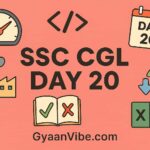GyaanVibe is a focused educational platform dedicated to helping SSC CGL aspirants crack Tier 1 & Tier 2 exam with a strategic, day-wise, and well-structured preparation approach.
SSC CGL Preparation – Day 14
Reasoning: Analytical Reasoning
📘 What is Analytical Reasoning?
Analytical Reasoning tests your logical thinking and ability to analyze complex situations or patterns. It involves understanding relationships, deducing outcomes, and solving problems logically using a structured and critical thinking approach.
🔍 It’s common in SSC CGL Tier 1 & 2 exams, often disguised in puzzles, seating arrangements, and direction-based scenarios.
📌 Types of Questions in Analytical Reasoning
- Seating Arrangements (Linear & Circular)
- Ranking and Order
- Direction-Based Puzzles
- Age-Based Problems
- Comparison Puzzles
- Blood Relation-based Puzzles
- Conditional/Selection-based Reasoning
- Binary Logic / Truth-Tellers and Liars
1. Seating Arrangement
a) Linear Seating Arrangement
People are sitting in a row facing same or opposite directions.
➡️ Trick:
- Mark left-right based on direction.
- Use variables and draw lines.
- Fill fixed positions first.
🧩 Example:
A, B, C, D, and E are sitting in a row. C is between A and E. D is at one end. Who is sitting at the other end?
✅ Solution: Try placing C between A & E → D at one end → answer is B at other end.
b) Circular Seating Arrangement
People sit in a circle, facing inward or outward.
➡️ Trick:
- If facing center, left is clockwise.
- If facing outward, left is counterclockwise.
- Use arrows and sketch all possibilities.
🧩 Example:
6 people sit around a circle facing center. A is second to the left of B. C is opposite A. Who is to the immediate right of C?
2. Ranking & Order
🧠 These questions involve finding the position of a person/item in a sequence based on certain clues.
➡️ Common Formula:
Total = Left Rank + Right Rank – 1
🧩 Example:
In a class of 50, Raju is 12th from the top. What is his rank from the bottom?
✅ Ans: 50 – 12 + 1 = 39th from the bottom
3. Age-Based Reasoning
These involve comparing people’s ages using statements like:
“A is older than B but younger than C.”
➡️ Trick:
- Use arrows or numbers
- Convert clues to inequality chains
🧩 Example:
Ravi is older than Raju but younger than Suraj. Kiran is younger than Raju. Who is oldest?
✅ Ans: Suraj
4. Direction Sense (Analytical)
Combine movement + direction turns.
➡️ Key Angles:
- Right turn = 90° clockwise
- Left turn = 90° counterclockwise
- Opposite = 180°
- Always draw a map!
🧩 Example:
A walks 5 km North, then turns right and walks 3 km. Then turns right again and walks 5 km. Where is he from starting point?
✅ Ans: 3 km East of starting point.
5. Comparison Puzzles
Involve comparing height, weight, marks, speed, etc.
🧩 Example:
A is taller than B. C is shorter than A but taller than B. Who is tallest?
✅ Ans: A
6. Blood Relation-based Puzzles
🧠 Combination of family tree + logical deduction.
🧩 Example:
A is mother of B. B is sister of C. C is father of D. How is A related to D?
✅ Ans: Grandmother
7. Conditional Selection (Logical Eligibility)
These involve selecting people/items based on multiple conditions.
🧩 Example:
A team of 3 is to be selected from 5 people: A, B, C, D, and E. But if A is selected, B cannot be. C and D must be together. Which teams are possible?
✅ Ans: Use elimination + grouping.
8. Binary Logic / Truth-Teller-Liar Problems
Some statements made by people are true or false.
🧩 Example:
A says, “B always lies.” B says, “A and I are friends.” Who is lying?
✅ Ans: Use logical contradiction to find liar.
📋 SSC CGL-Level Practice Question
Q1. Six friends A, B, C, D, E, and F are sitting in a circle. A is to the left of B, who is opposite F. D is between A and C. Who is sitting to the right of E?
Q2. In a row of 35 students, Ramesh is 8th from the left and Suresh is 10th from the right. How many students are there between them?
🧠 Tips to Crack Analytical Reasoning
- Sketch quickly – don’t solve in your mind
- Eliminate impossible options
- Use notations: < for shorter, > for taller, ↔ for siblings, etc.
- Read clues carefully – word order matters
- Practice puzzles daily – builds pattern recognition
📝 Daily Practice Challenge
- Solve 2 linear and 2 circular seating puzzles
- Practice 3 ranking/order problems
- Practice 3 age or comparison puzzles
- Review 1 previous year SSC CGL analytical puzzle




